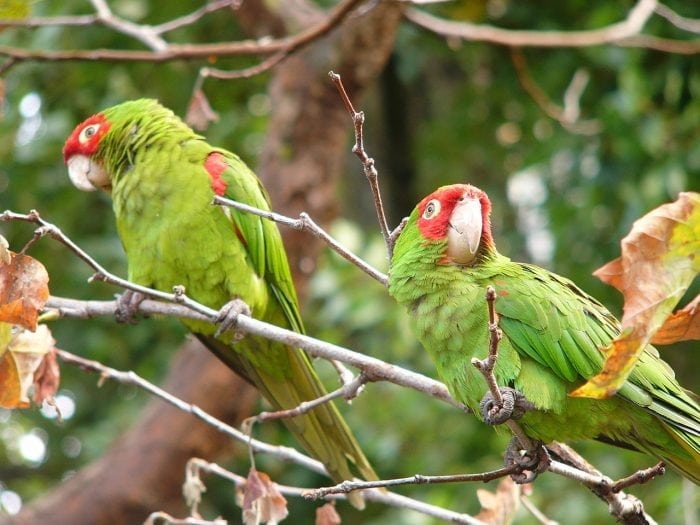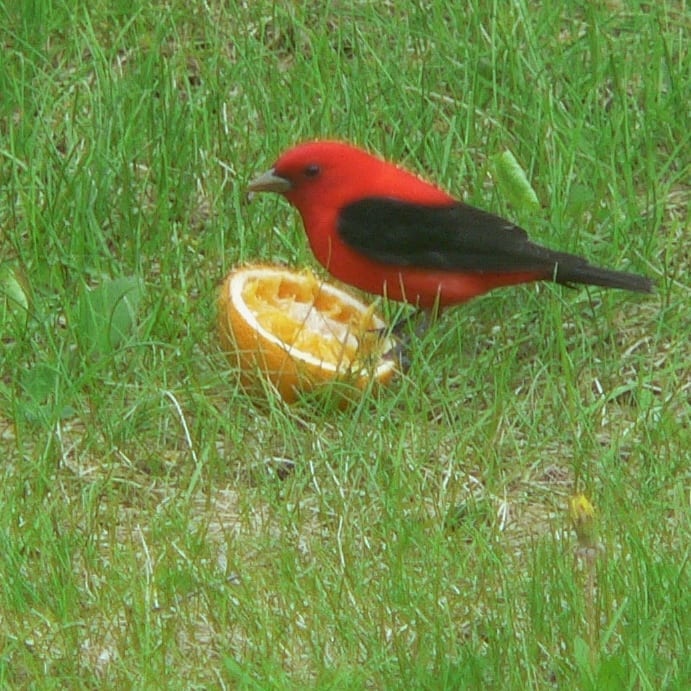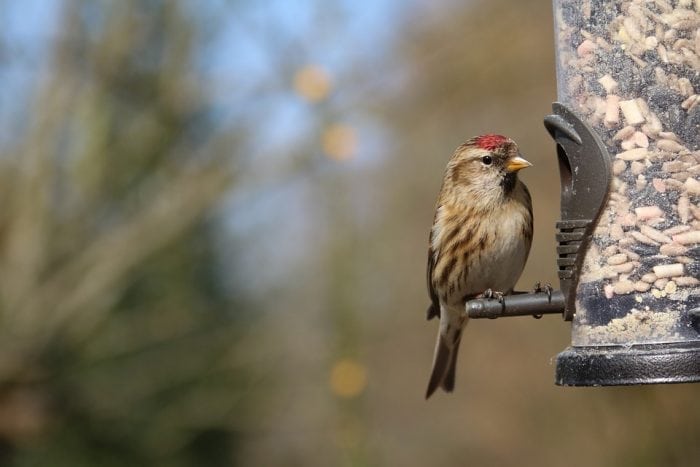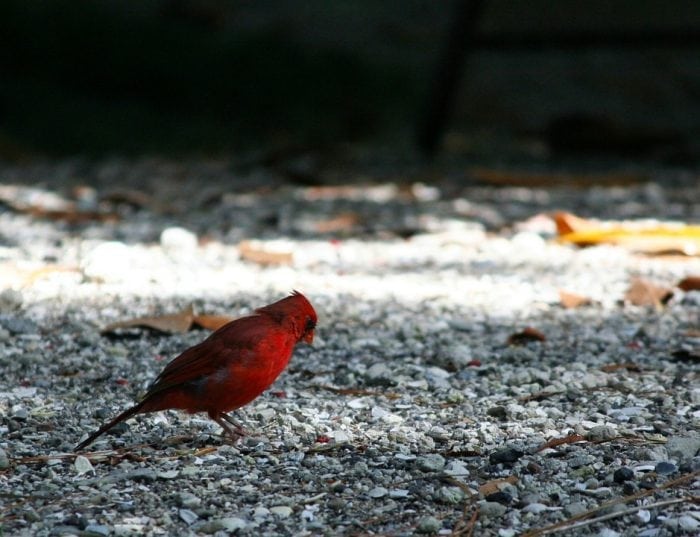
If you’re birdwatching, hiking trails, or just hanging out in your backyard and spot a bird with a red head, you may want to know how to identify it. A bird with a bright red head of feathers is likely going to be one of the following types: woodpeckers, the Cherry-headed Conure, a tanager, a redpoll, or the northern cardinal.
You can use the following information about them, like their size, body type, habitat, and other attributes to classify the bird and know what kind you’re probably looking at.
“A bird doesn’t sing because it has an answer, it sings because it has a song.” — Maya Angelou
Recognizing Types Of Woodpeckers

Photo: skeeze via Pixabay, CC0
Woodpeckers are probably the most easily recognizable bird on this list. Their bright red head is easily noticeable, though they are frequently depicted as having prominent tufts, in reality, their tufts are less pronounced than caricatures of them depict. Woodpeckers can be found throughout much of North America, and are distinguishable not only by their red plumage on their heads but by their black and white wings and their white breasts. They make a distinctive knocking noise on the bark of trees when they pick at them, so use that as another indicator of what bird you are looking at. Woodpeckers sometimes catch grasshoppers and stuff them into small crevices in tree bark to eat them later. North America varieties of woodpeckers include the northern flicker, the red-breasted sapsucker, Lewis’ woodpecker, and the red-naped sapsucker.
There are specific varieties of woodpeckers referred to as red-bellied woodpeckers. While other woodpeckers usually have a red head, the red-bellied woodpecker has a red streak across their torso starting at the beak. The winds of the red-bellied woodpecker have black and white spots or stripes, somewhat like zebras. Outside of North America, woodpeckers can be found in many regions of the world, including in South Asia (the Black-rumped flameback). Woodpeckers are a surprisingly adaptable type of bird that has managed to spread across much of the globe. Currently, the bird is only absent from regions like Australasia and Madagascar (and Antarctica). They can be found throughout Africa, North America, Southeast Asia, and South America. South America actually has the greatest diversity of woodpeckers in the world.
“A woodpecker’s drilling echoes to the mountain clouds.” — Dakotsu Iida
Red-Headed Conures

Photo: By Jef Poskanzer – Flickr, CC BY 2.0, https://commons.wikimedia.org/w/index.php?curid=3744553
Conures, also known as parrots, belong to the order Psittaciformes. The red-headed conure is sometimes referred to as the red-masked parakeet or the cherry-headed conure. The birds can be found throughout Peru and Ecuador, but they are also popular pets. The birds can learn to talk and are in fact considered one of the best talkers out of the family of parrots.
Two Types Of Tanagers With Red Heads

A scarlet tanager. Photo: By M C Morgan from Bemidji MN, USA – Scarlet Tanager, CC BY-SA 2.0, https://commons.wikimedia.org/w/index.php?curid=8879268
There are two different types of tanagers that have red heads. The scarlet tanager and the summer tanager both have red heads (they are actually in the same order as the northern cardinal). Summer tanagers look very similar to northern cardinals (below), though they lack the black “masks” that northern cardinals have. The summer tanager frequently eats wasps and bees, removing the stinger before doing so. The scarlet tanager looks very similar to the summer tanager (and thus similar to the northern cardinal), but it has a stouter beak than the summer tanager. The coloring of the scarlet tanager is almost entirely red except for black wings and tails. No other bird within the US has this color pattern.
These two tanagers can be found throughout much of the United States, and in southern latitudes, as they tend to migrate to Mexico and Central America during the winter season. The two tanagers belong to either the cardinal family or to the family Thraupida, as there is some debate about how to classify the birds. There are other species of tanagers with red heads, such as the Brazilian tanager, which can be found in Brazil and Argentina.
Recognizing Redpolls

Photo: jLasWilson via Pixabay, CC0
Redpolls are small finches within the Fringillidae family, found mainly in the northern hemisphere though some populations can be found in the southern hemisphere where they have been introduced. The common redpoll and the Arctic redpoll both have noticeable red “caps” on their heads. The Arctic redpoll is found throughout most of Canada and Greenland, and the birds don’t usually migrate to more southern regions during the winter, though certain populations might. The birds are surprisingly resistant to cold temperatures, so they have little need to migrate. The common redpoll, on the other hand, will migrate south to find more abundant food supplies. The common redpoll can be found throughout Asia, Europe, and North America. Redpoll birds, both the common redpoll and the Arctic redpoll, can sometimes be witnessed passing seeds to each other.
“In order to see birds, it is necessary to become part of the silence.” — Robert Lynd
The Northern Cardinal And More

Photo: JamesDeMers via Pixabay, CC0
The northern cardinal can be found throughout much of the north American continent. The eastern half of the United States, as well as the southern US and much of Mexico, is home to the bird. The bird is actually completely red, head included, except for one small black section over their face that resembles a mask. The males of the species are known for their bright red plumage, while the females of the species tend to be a duller reddish-brown color. The northern cardinal also has a distinctive birdsong, which they make when claiming territory. It’s a loud, sharp whistle usually made from the top of a tree and done to discourage other males from entering the territory.
Some forms of finches, apart from the common redpoll, also have red heads. Cassin’s finch is in the family fringillidae, much like the redpoll. Also similar to the redpoll is the bright red collection of feathers found on their head, back, rump and breast. The back of the finch is usually streaked brown. Once more, the males of the species have red on their heads while the females of the species are a more muted brown with interleaved cream colored feathers. This makes them a sexually dimorphic species. Cassin’s finch belongs to the genus Haemorhous, which includes the purple finch and the house finch as well.









